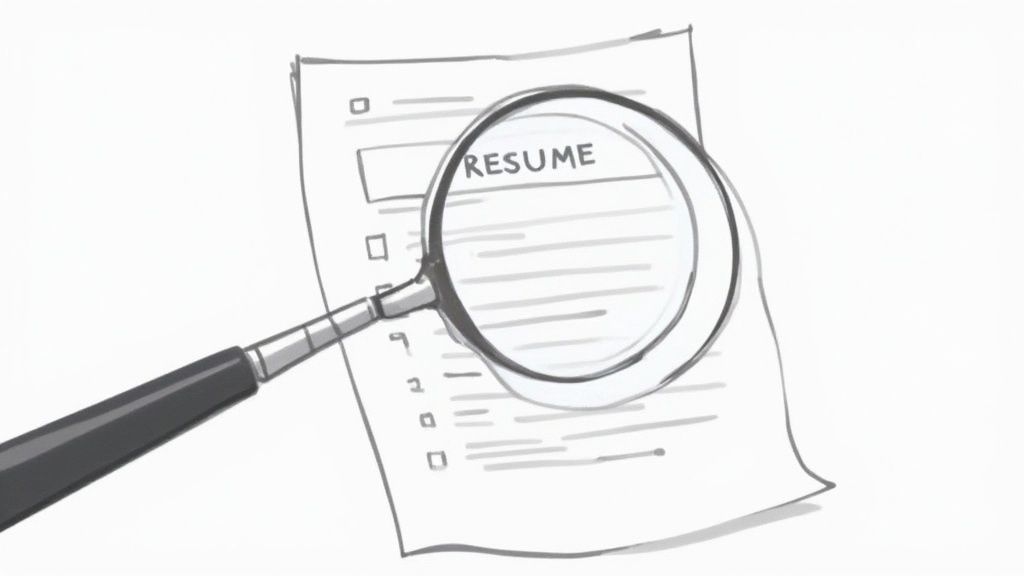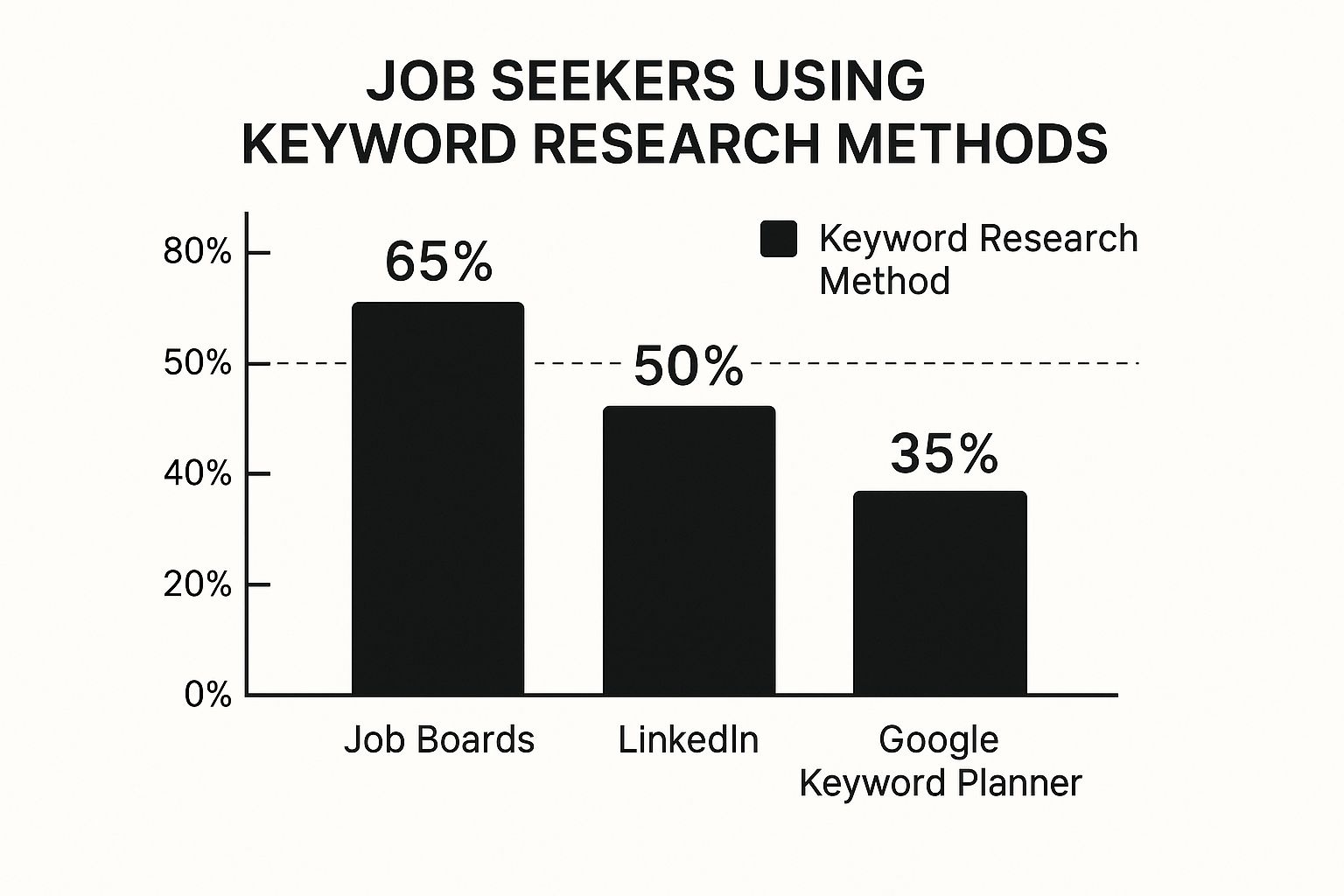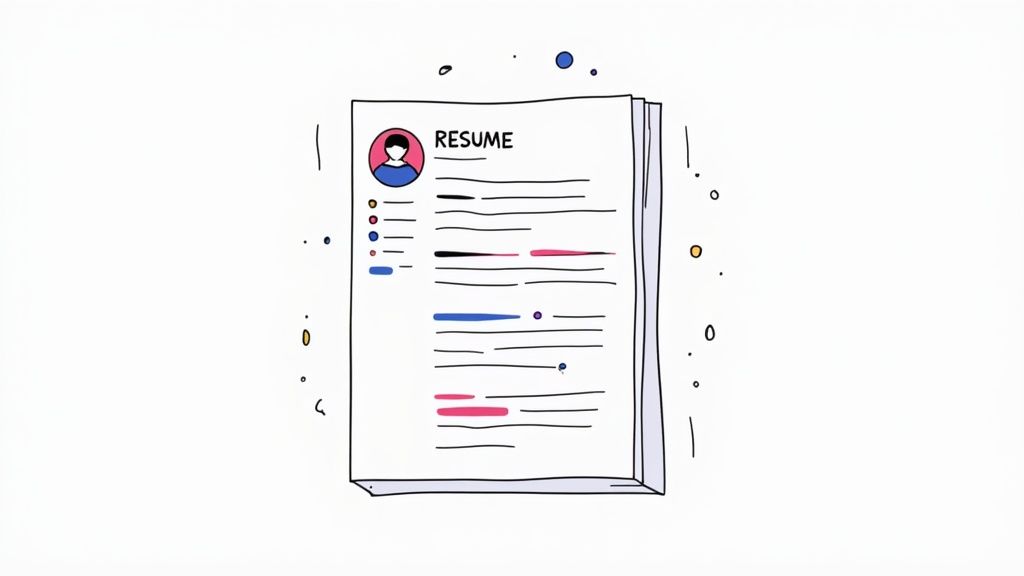
Mastering Job Search Keywords to Land More Interviews
Job search keywords are the specific terms—think skills, software names, and qualifications—that recruiters and hiring managers plug into their systems to find people just like you. They’re the secret handshake that gets your application past the digital gatekeepers and onto a real person’s screen.
Why Job Search Keywords Are Your Secret Weapon

Let’s get real for a moment. Having incredible experience doesn’t guarantee you an interview. If you’ve ever felt like your resume vanished into a black hole after you hit “submit,” you’re not imagining things. The problem usually boils down to a simple mismatch between the words you’re using and the ones the hiring manager is searching for.
This all comes down to Applicant Tracking Systems (ATS). These platforms are the first line of defense for most companies, automatically scanning every single application. And when I say “most,” I mean it—over 90% of large companies use an ATS to filter candidates. If your resume doesn’t contain the right keywords, a human will likely never even know you applied. It’s not just about what you did anymore; it’s about how you say it.
Here’s How It Plays Out
I once worked with a project manager who had a decade of fantastic experience. She was applying to dozens of perfect-fit roles but kept getting automated rejection emails. It was incredibly frustrating. When we looked at her resume, we saw it was full of internal company jargon and vague phrases like “responsible for project execution.”
Meanwhile, the job descriptions were crystal clear about what they wanted:
- Agile Methodologies
- Stakeholder Management
- Jira & Confluence
- Budget Forecasting
We retooled her resume to include these exact terms, and within a week, she started getting calls for interviews. Her qualifications didn’t change, but the way she presented them did. She learned to speak the language of the recruiter.
Your resume isn’t just a dry history of your career. It’s a marketing document designed to beat an algorithm first and impress a human second. The keywords you choose are the most powerful tool you have.
Keeping Up with a Changing Job Market
This keyword strategy is only becoming more important. The job market is shifting under our feet, with AI-powered matching algorithms now influencing about 60% of job listings. Projections from the World Economic Forum’s Future of Jobs Report 2025 suggest these changes will impact 22% of all jobs globally by 2030.
To stay competitive, you have to think like these systems. That means weaving in keywords that reflect what companies need now and in the future, like ‘cybersecurity,’ ‘agility,’ and ‘resilience.’ It’s time to stop just listing what you’ve done and start strategically showcasing your skills with the precise language recruiters are searching for.
Finding the Right Keywords for Your Target Role
Okay, let’s get down to business. Knowing you need keywords is one thing; actually finding the right ones is where the magic happens. This isn’t guesswork. It’s a bit like being a detective, and your primary crime scene is the job description itself.
I always tell people to start by pulling up three to five job postings for the role they want. Put them side-by-side and grab a highlighter (digital or physical, your choice). Start marking every skill, software, or qualification that pops up in more than one description. You’ll see a pattern almost immediately. For a senior marketing role, you’ll probably see terms like “stakeholder management,” “Scrum,” and “go-to-market strategy” over and over. Those are your golden tickets.
This image breaks down how most job seekers are tackling this exact task.

It’s clear that job boards are the go-to, but a lot of savvy professionals are also using LinkedIn to get an edge. That leads me to my next favorite trick.
Reverse-Engineer Success on LinkedIn
Want a shortcut to see what works? Find people who already have the job you want at the companies you’re targeting. Hop on LinkedIn, search for that exact job title, and start analyzing their profiles. Pay close attention to their “About” and “Skills” sections. What words do they use to talk about what they do?
This is a fantastic way to peek behind the curtain. You’ll uncover industry jargon and valuable soft skills that job descriptions often leave out, but are clearly what got these people hired.
Pro Tip: Your main goal here should be to build a master list. Open up a simple document and start dropping in every relevant hard skill, soft skill, tool, and industry term you find. This will become your personal keyword bank for every application.
Once you’ve got that list, you’re ready to start weaving those words into your resume and cover letter. For a detailed playbook on that, check out our guide on how to tailor your resume to a job description.
Aligning with What the Market Demands
It’s also critical to understand what’s happening in the broader job market. In 2025, we’re seeing a strange situation: job openings are up, but unemployment isn’t dropping as fast as it should. A big reason for this is a skills and keyword mismatch. Jobs sit empty because candidates aren’t speaking the same language as employers.
Hot-button keywords like “AI,” “automation,” and “sustainability” are becoming non-negotiable in many fields. Candidates who know how to include them are the ones getting shortlisted. This isn’t just about collecting words; it’s about understanding the story they tell about what companies desperately need right now.
Categorizing Your Keywords for Maximum Impact
To make your master list truly useful, you need to organize it. Breaking your keywords down into a few simple categories helps ensure your resume presents a well-rounded picture of who you are and what you can do.
Here’s a quick look at the main types of keywords you’ll be hunting for and where you’re most likely to find them.
Keyword Types and Where to Find Them
| Keyword Type | Description | Primary Source Examples |
|---|---|---|
| Hard Skills | Teachable, quantifiable abilities. | Job descriptions, LinkedIn Skills sections, online courses. |
| Soft Skills | Interpersonal attributes related to how you work. | Company “About Us” pages, performance reviews, job descriptions. |
| Industry-Specific Terms | Jargon, tools, or methodologies unique to your field. | Industry news sites, professional networking groups, competitor job ads. |
| Certifications/Software | Specific qualifications, tools, or platforms. | Job descriptions (under “Requirements”), employee LinkedIn profiles. |
Sorting your findings this way makes it much easier to sprinkle them naturally throughout your application materials. By putting in this research up front, you’re building a powerful foundation that will get you past the bots and in front of a real human.
Weaving Keywords Into Your Resume and Cover Letter

Alright, you’ve got your master list of keywords. That’s a huge first step, but what you do next is what really counts. Just dropping them into your resume at random isn’t going to cut it. The real art is weaving them into your professional story so seamlessly that they impress both the scanning software and the human who actually reads your application.
This is all about moving beyond bland, generic statements. We need to transform those duties into powerful, evidence-backed accomplishments. The goal is to show what you did, not just tell them. Your keywords are the building blocks you’ll use to do it.
Upgrading Your Resume Bullet Points
Let’s get practical with a real-world example. I see this kind of bullet point on resumes all the time:
- Before: Managed projects and led a team.
This is far too vague. It has zero searchable keywords and tells a hiring manager almost nothing about your actual skills or impact. Now, let’s inject it with some of those terms from your keyword research, along with concrete metrics to back it up.
- After: Managed a $500K project portfolio using Agile methodologies and Jira to track progress, increasing team efficiency by 20% and delivering all milestones ahead of schedule.
See the difference? This version is a total game-changer. It’s packed with valuable keywords like “Agile methodologies” and “Jira,” includes real numbers, and paints a vivid picture of your competence. This is exactly what gets an ATS to flag you as a top candidate.
Your resume should read less like a list of duties and more like a highlight reel of your greatest hits. Every bullet point is a chance to plant a keyword and prove your value with data.
Strategic Keyword Placement on Your Resume
To get the most bang for your buck, you need to place keywords in the sections that both applicant tracking systems and recruiters scan first. Think of these as the prime real estate on your resume.
Focus your energy on these three critical areas:
- Professional Summary/Headline: This is your elevator pitch right at the top of the page. It needs to immediately signal what you do and should feature 2-3 of your most important keywords. For a data analyst, it might read: “Data Analyst with expertise in SQL, Tableau, and Python.”
- Skills Section: This is the perfect home for all those hard skills, software proficiencies, and technical abilities. Don’t just list them in a blob of text. Break them into categories for readability (e.g., “Programming Languages,” “Data Visualization Tools”). This simple trick makes it easy for an ATS to parse and for a human to quickly scan.
- Work Experience Section: Just like in the example above, your work history is where you give those keywords context. Start each bullet point with a strong action verb, then weave in the keywords that describe the tools, skills, and methods you used to get a specific, measurable result.
Bringing Keywords into Your Cover Letter
Your cover letter isn’t just a formality—it’s your chance to tell the story your resume can’t. While the resume lists what you did, the cover letter explains why you are the perfect person for this specific role at this specific company.
Instead of just rehashing your resume, use the cover letter to connect your skills directly to the company’s pain points, using the exact language from the job description. If the posting mentions “cross-functional collaboration” multiple times, dedicate a short paragraph to a specific time you led a project that brought multiple departments together.
This narrative approach makes your application far more memorable and proves you’ve done your homework. If you’re looking to speed this part up without losing quality, an AI cover letter generator can give you a solid, keyword-rich draft to personalize. By thoughtfully integrating keywords across your entire application, you create a cohesive package that speaks directly to what the employer is looking for.
Using Keywords for a Smarter Online Job Search

Alright, your resume is now packed with the right keywords to beat the bots. The next step? Turning that same keyword strategy outward to hunt for jobs more effectively. The very same terms that make your resume ATS-friendly can completely change how you find roles on job boards like LinkedIn, Indeed, and Google Jobs.
It’s time to stop the endless, passive scrolling and start actively targeting the right opportunities with surgical precision.
The real trick is learning to “speak the language” of the search bar. With a few simple commands, you can slice through the digital noise and pinpoint roles that are a genuine match. Think of it as giving the job board a very specific, non-negotiable set of instructions.
A generic search for “Data Analyst,” for instance, will likely flood you with thousands of results—everything from internships to director-level roles you aren’t qualified for. It’s overwhelming and a massive waste of time. A smarter search, however, changes the game entirely.
Becoming a Power Searcher with Boolean Logic
You don’t need to be a programmer to use these commands. In fact, they’re surprisingly simple and will save you hours of frustration. Let’s walk through a couple of real-world scenarios to see how you can refine your job search keywords and get much better results.
Imagine you’re a data analyst with a few years of experience. You’re ready for your next move, but you’re tired of sifting through posts for recent grads or seasoned veterans.
You could search for this: "Data Analyst" NOT "Senior" NOT "Entry-Level"
What this does is tell the search engine to find jobs with the exact phrase “Data Analyst” but to exclude any listing that also mentions “Senior” or “Entry-Level.” Just like that, you’ve filtered out the irrelevant noise and your results are instantly more targeted.
By mastering a few key search commands, you shift from being a passive job seeker to an active hunter. You control the results you see, rather than letting the algorithm decide for you.
To give you a better toolkit, I’ve put together a quick guide on the most useful commands. These are your new best friends for job hunting.
Boolean Search Commands for Smarter Job Hunting
Simple commands to refine your searches on job boards and find exactly what you’re looking for.
| Command | Example Usage | What It Does |
|---|---|---|
"" | "Product Marketing Manager" | Searches for that exact phrase, not just the individual words. Essential for specific job titles. |
NOT | Marketing NOT Manager | Excludes terms from your search. Great for filtering out roles that are too senior or too junior. |
AND | Sales AND "Account Executive" | Ensures all specified terms appear in the job listing. Good for combining a skill with a job title. |
OR | Writer OR Editor | Broadens your search to include listings with either term. Useful for roles with similar titles. |
() | (Sales OR Marketing) AND Manager | Groups terms together to create more complex, layered searches. This finds manager roles in either field. |
Using a combination of these will make you feel like you have a superpower. You’ll spend less time sifting and more time applying to jobs that are actually a good fit.
Optimizing Your LinkedIn Profile for Recruiters
Your online job search isn’t just a one-way street. It’s not only about what you look for; it’s also about how easily recruiters can find you. Many of the best jobs are never even posted publicly because recruiters actively source candidates by searching for specific skills and titles on platforms like LinkedIn.
This means your LinkedIn profile needs to be just as keyword-rich as your resume. I always tell people to focus on two high-impact areas:
- Your Headline: Don’t just list your current job title. Pack it with valuable keywords. Instead of “Marketing Manager at ABC Corp,” try something like “Marketing Manager | Digital Strategy | SEO | Content Marketing.” It immediately tells a recruiter what you do.
- Your ‘About’ Section: This is your prime real estate. Weave the keywords you’ve researched into a compelling narrative about your career, skills, and accomplishments. It should sound natural, not like a list of buzzwords.
This proactive approach essentially turns your profile into a magnet for the right kind of recruiters.
Interestingly, where you apply can make a huge difference. A recent Q2 2025 study of over 461,000 applications found that while job seekers save the most jobs on LinkedIn, applications submitted through Google Jobs actually get triple the callback rate.
You can check out the full job search trend findings for more insights. The takeaway here is that a consistent keyword strategy across all channels—from your resume to your search habits to your LinkedIn profile—is what truly maximizes your visibility.
Common Keyword Mistakes That Hurt Your Chances
Getting your keywords right is a huge advantage, but it’s just as easy to get them wrong. I’ve seen countless applicants with great experience get overlooked because they fell into a few common traps. Knowing what not to do is just as critical as knowing what to do.
Let’s start with the biggest offender: keyword stuffing. This is an old-school tactic of cramming as many keywords as possible into a resume, hoping to trick the system. Today’s Applicant Tracking Systems are smart enough to spot this a mile away. They’re designed to recognize natural language, and a resume that reads like a glossary of buzzwords gets flagged instantly.
Even if you slip past the ATS, a human is the final gatekeeper. When a hiring manager sees a document overloaded with repetitive terms, it screams desperation, not expertise. It looks like you’re trying to game the system, and it’s an immediate red flag.
Vague Language and Generic Phrases
Another classic mistake is leaning on generic, tired phrases. Think about how many times you’ve seen words like “team player,” “results-driven,” or “hard-working.” They’ve become so overused they’re practically meaningless. These clichés are just filler—they take up precious real estate on your resume without communicating any real value.
Your resume is a marketing document, and every single word counts. Vague language dilutes your message and makes you sound just like everyone else.
Instead of just saying you’re a “team player,” show it. A simple shift from a generic claim to a specific accomplishment makes all the difference. For example, “Collaborated with a cross-functional team of five to launch a new product feature in Q3” not only proves your teamwork but also naturally weaves in stronger keywords like “cross-functional team” and “product launch.”
The One-Size-Fits-All Resume
The single most damaging mistake you can make is sending the same resume out for every application. This “spray and pray” approach is the fastest way to the rejection pile. Every company has unique needs, and every role has a specific set of requirements. If you don’t customize your application, you’re missing a golden opportunity to show you’re the perfect fit for that specific job.
Your resume and cover letter should always be a direct answer to the job description. This same logic applies to your cover letter, where a generic template can sink your chances before you even start. To dig deeper on this, check out these common mistakes to avoid in AI-generated cover letters, as the principles are closely related.
Let’s look at a quick before-and-after:
- What Not to Do: A dedicated, results-oriented team player with a proven track record.
- What to Do: Project Manager with 5+ years of experience in Agile methodologies and Jira, leading teams to deliver projects 15% under budget.
See the difference? By sidestepping these common mistakes, you let your carefully chosen keywords do their job, presenting you as the sharp, qualified, and thoughtful candidate you are.
A Few Lingering Questions About Job Search Keywords
Alright, let’s tackle a couple of the most common questions that pop up once you start putting this keyword strategy into action. Getting these details ironed out will give you that extra bit of confidence when you hit “apply.”
So, How Many Keywords Is Too Many?
This is a big one. While there isn’t a single magic number, my rule of thumb is to focus on quality over quantity every single time.
Instead of trying to cram every keyword you can find into your resume, aim for the 10-15 most critical keywords for that specific job. Weave them naturally into your professional summary, your skills list, and especially into the bullet points describing your work experience.
Your goal is to reflect the language of the job description, not to bombard it. Think of it like this: a resume that feels authentic and targeted will always outperform one that’s obviously stuffed with buzzwords. It’s about seasoning your application perfectly, not overwhelming the reader.
Do I Really Need to Copy Keywords Word-for-Word?
Yes, but it’s all about context. Modern Applicant Tracking Systems can be surprisingly literal. If the job ad specifically asks for “data analysis” and your resume mentions “analyzing data,” a less sophisticated system might not make the connection.
For essential hard skills and software—think Python, Salesforce, or Adobe Creative Suite—you absolutely want to use the exact phrasing you see in the posting.
The trick is to blend these exact-match terms into your accomplishment statements. Don’t just create a laundry list of keywords. This approach ensures your resume gets past the initial ATS scan and then impresses the human hiring manager who will read it next.
I’ve seen this myth pop up a few times: the idea that you can hide keywords in white text to “trick” the ATS. Please don’t do this. It’s a terrible, outdated tactic. Most modern systems will either ignore the text completely or, even worse, flag your application as spam.
Hiring managers can easily spot this trick, and it instantly tanks your credibility. Stick to well-written, transparent content. Your actual experience, framed with the right keywords, is what will truly get you noticed.
Ready to stop guessing and start getting noticed? Jobcamp uses AI to instantly generate customized resumes and cover letters packed with the right keywords for any job. Ditch the manual work and land more interviews today. Get started for free at https://www.jobcamp.ai.

